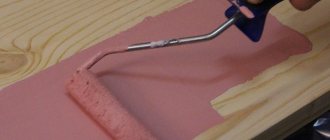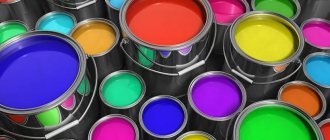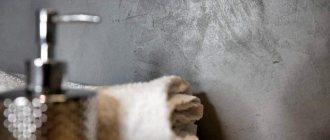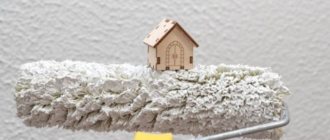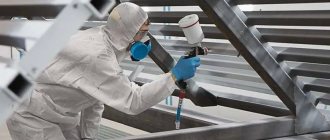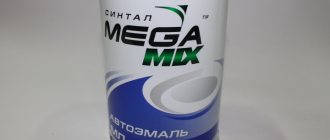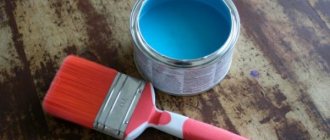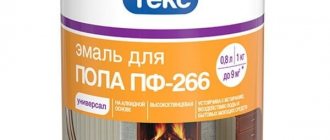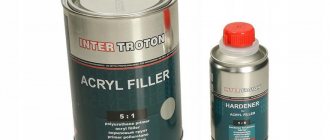Peculiarities
Alkyd enamel appeared relatively recently and in a short period of time was able to gain popularity, displacing other types of paint and varnish coatings.
This product is distinguished by its versatility, due to which it is actively used not only for interior work (finishing floors and walls), but also for exterior repairs.
The defining difference between alkyd enamel and acrylic enamel is resistance to mechanical damage, as well as the ability to perfectly resist abrasion. Even after many years, the surface finished with alkyd enamel continues to retain its attractive appearance.
Thus, among the main features of this type of enamel one can highlight its impressive elasticity and durability.
The material requires a minimum amount of time to dry, so it can be used in any room.
Another advantage of this type of paint coating is that it does not turn yellow over time and does not lose its original color.
Marking
In order to correctly select the required alkyd enamel, you should familiarize yourself with the markings, which indicate the scope of its application:
- Alkyd primer – 0;
- Suitable for exterior decoration – 1;
- Alkyd paint for interior work – 2;
- Used for conservation work – 3;
- Alkyd waterproof enamel – 4;
- Special purpose – 5;
- Increased resistance to petroleum products – 6;
- Suitable for providing protection against aggressive environments – 7;
- Resistance to temperature changes – 8;
- Used for painting electrical wiring – 9.
Characteristics
The unique characteristics of alkyd enamel make it possible to use it during work outdoors, since the material is not afraid of the influence of rain and snow, temperature changes and the rays of the sun. The product contains cutting-edge components that provide reliable protection of the material from the corrosion process.
This is why it is actively used for finishing metal and wooden objects.
Among the most popular options are the following varieties:
- Quick drying. In most cases, it contains driers and various solvents. Thanks to this, the drying process takes a minimum amount of time, which makes alkyd enamel an ideal solution for interior decoration.
- Melamine-alkyd. The peculiarity of this material is that this variety boasts impressive adhesion, which is why melamine alkyd types are used for painting metal.
- Alkyd-urethane. It is a mixture of pigments and targeted additives, which also includes special driers.
Alkyd enamel is obtained by mixing alkyd varnish and special solvents. However, other components can also be added to the paint: to give a certain color, to provide corrosion resistance and other additives.
If it is necessary to ensure the resistance of the material to various fungal infections and prevent the development of mold, then antiseptics are added to the product composition.
It should be noted that, like most other paints and varnishes, enamel, if not used for a long time, can lose its properties and change consistency, which can only be returned by adding a special solvent.
The main component of such enamel is alkyd varnish, which can be of two types:
- Pentaphthalic is a special resin composition to which glycerin and natural oils are added. The main advantage of this component is that it boasts its resistance to water.
- Glypthal. The composition has a high drying speed, which varies from 24 to 6 hours.
paints and varnishes
0 votes
+
Vote for!
—
Vote against!
There are a great variety of alkyd enamels. This paint coating is distinguished by its versatility, abrasion resistance, and bright colors. It can be used for both interior and exterior work, and due to the fact that alkyd enamel paint can be glossy, matte, or semi-matte, its scope of application is almost limitless.
Content:
- Composition of alkyd enamels and their properties
- Features of alkyd enamels
- Classification of alkyd enamels
- Alkyd enamel GF-230
- Alkyd enamel PF-133
- Alkyd enamel PF-115
- Alkyd enamel PF-223
- Alkyd enamel PF-253
- Alkyd enamel PF-126
- Matte enamels
- Aerosol enamels
- Manufacturers of alkyd enamels
Composition of alkyd enamels and their properties
Alkyd enamels are made on the basis of alkyd varnish and various solvents with filler. In addition, they contain coloring pigments that give the coating a certain color. Sometimes the manufacturer may include various additives in the combination, for example, antiseptics that protect the painted surface from mold and fungal infections. The main solvent for alkyd enamels is white spirit. By the way, this is what you should use if the paint has thickened. And the fillers are usually sand, granite or marble chips and other materials that have the same properties. Fillers for paint and varnish coatings should not be confused with traditional sand and crumbs - their grinding is much finer and the structure of these materials is more similar to flour.
The most important component of alkyd enamels is alkyd varnish, which comes in two types: pentaphthalic and glypthal. Most often, in the production of paints, pentaphthalic varnish is used, which is a thick solution of resin in a solvent with the addition of vegetable oils, rosin and glycerin. The finished varnish is later mixed with a solvent to form an alkyd enamel.
Features of alkyd enamels
The features of alkyd enamels include their high elasticity and durability. Such coatings dry quickly enough, which allows them to be used indoors without much concern. In addition, such paints do not turn yellow when dry, do not lose their color, or shrink.
They are also suitable for outdoor work, since they have high weather resistance - snow, rain, and temperature changes are not a problem for alkyd enamels.
This type of paint coating perfectly protects various metal surfaces (doors, windows, radiators, furniture, etc.) from corrosion; it is also able to withstand wet cleaning with conventional detergents and can be used in bathrooms, saunas and swimming pools.
Classification of alkyd enamels
Depending on the classification, alkyd enamels have different properties, methods and areas of application. Each brand has its own alphanumeric code, which allows you to determine whether the enamel belongs to a particular category. For example, alkyd enamel PF-120 matte white is deciphered as follows: PF - pentaphthalic (these letters indicate the substance that is used in the paint as a base); the number 1 means that the enamel can be used for outdoor work, and the number 20 is the catalog number.
In addition to the unit, other numbers can be found on alkyd enamels: the number “ 0 ” indicates alkyd primer enamel, that is, a coating intended for priming surfaces;
2 — enamel for indoor use (heated and unheated);
3 — conservation paints, that is, paints and varnishes that are intended for temporary sealing of any equipment;
4 - waterproof paints;
5 — special paints with special characteristics (rodent repellent, glow in the dark, etc.);
6 — oil and petrol resistant enamels;
7 — paints that can withstand chemical attack;
8 — heat-resistant paints;
9 — electrically conductive and electrically insulating paints.
Alkyd enamel GF-230
In this case, GF is glyphthalic. This paint is intended only for interior painting of ceilings and walls. It cannot be used for painting floors, since it does not withstand physical influences well. Before you start using the enamel, it must be diluted to the desired consistency with white spirit or turpentine. There are quite a few shades of glyphthalic enamel GF-230, ranging from light cream to dark colors. It can be applied with a brush, roller or spray. It dries in about a day and has a distinct varnish smell.
Alkyd enamel PF-133
It is used for painting metal surfaces or surfaces that have been pre-primed. It is usually applied in two layers, since its covering ability is not too high (ranging from 20 to 120 g/m2). Dries in 2 hours and comes in 15 subtle shades. In temperate climates, PF-133 enamel retains its protective properties for 5-6 years, and it does not crack or deform.
Alkyd enamel PF-115
Designed for exterior painting of metal, wood and other surfaces. This enamel needs to be applied in two layers, since its covering ability is not too high (30-120 g/m2). Available in 24 shades, applied by spray or brush, drying from 8 to 24 hours. Alkyd glossy enamel PF-115 has a pleasant shine, giving the surface a bright, rich color.
Alkyd enamel PF-223
Its scope of application is interior finishing of wooden and metal surfaces. This alkyd enamel is perfect for radiators - it has 17 shades to suit every taste, hides old paint well and withstands high temperatures well. Diluted to the desired consistency with solvent, gasoline or xylene. Drying time 30-36 hours. The smell is specific, pungent.
Alkyd enamel PF-253
Scope of application: pre-primed plank floors. Apply in two layers using a wide or medium brush. Diluted with turpentine or gasoline. Dries quickly (drying time depends on the thickness of the layer and the temperature inside the room). After drying, the surface acquires an even, flawless gloss.
Alkyd enamel PF-126
This type of enamel is sold complete with NF-1 filler, which accelerates hardening. Apply the paint with a brush or roller in two thick layers with intermediate drying of 30-40 minutes. Before application, the surface is primed with enamel diluted with white spirit.
Matte enamels
Sometimes matte alkyd enamel may be required to paint surfaces. As a rule, such paint is intended for both exterior and interior use. It is durable, resistant to water, detergents, and oils. Able to withstand temperature fluctuations from -50 to +60o C. It is economically consumed, as it has a high covering ability (90-180 g/m2). Diluted with solvent or white spirit.
Aerosol enamels
Aerosol alkyd enamel is easy to use, since there is no need for brushes and rollers, it fits well on any surface and dries very quickly (3-5 hours). It is able to penetrate into any cracks, so it is recommended to paint hard-to-reach places, and the scope of application of such paint is very wide: from garden furniture to stucco on the ceiling.
In addition to the above, there are other types of alkyd enamels, the purpose of which also applies to painting walls, ceilings, floors and other surfaces both outside and inside the house.
Manufacturers of alkyd enamels
On store shelves you can find a huge assortment of alkyd enamels, both Russian and foreign. How do the former differ from the latter?
Firstly, the majority of Russian manufacturers do not rely on packaging: paints are “packed” either in metal or plastic cans. Imported enamels, as a rule, have bright, attractive packaging that distinguishes “overseas” products from their Russian neighbors.
Secondly, a price of 200-300 rubles per liter jar is clearly not suitable for high-quality alkyd enamel, and these are the price tags that are sometimes found on shelves with Russian products. Imported analogues are many times more expensive.
Thirdly, expensive imported enamels contain only the highest quality components that have passed all kinds of tests. It is due to such “ingredients” that enamels produced abroad have virtually no odor, dry quickly, have a huge number of shades and are well distributed over the surface, leaving no streaks or smudges. For example, Tikkuril alkyd enamel "Miranol" is ideal for painting furniture, window frames, doors and even children's toys - its level of safety is so high. It is not yet possible to say something similar about Russian enamels, although our manufacturers have recently been trying to pay as much attention as possible to the environmental friendliness of their products.
When buying alkyd enamel, you should pay attention to its shelf life - the fresher the paint, the better and smoother the coating will be. Well, the most important thing is that you don’t need to chase cheap or expensive - choose the “golden mean” - you definitely won’t go wrong!
Classification of alkyd paints
Alkyd-based paints and varnishes have various characteristics that determine their purpose and application. Both paints for general use and special compositions intended for specific surfaces are produced.
On containers with enamel you can find an unusual combination - GF-230, PF-115 and others. What it is? This is a special marking used for ease of orientation in various types of alkyd paints.
Composition of alkyd and acrylic paints
The main component of alkyd paint is alkyd resin, which is a binding material obtained by boiling vegetable oils with organic and alcoholic acids or acid anhydrides. White spirit or turpentine are used as the main solvents.
Acrylic paints are of the water-dispersion type. The binding material in them is a dispersion of tiny particles of acrylic resin suspended in water. The pigment used is a dry, insoluble, finely dispersed powder that is suspended in the overall structure.
Types of alkyd enamels by chemical composition
The short abbreviation on the can's label helps identify the base used to create the paint. There are several types of markings:
- GF – paint based on glyphthalic varnish;
- PF – enamel on a pentaphthalic varnish base;
- CS - a mixture of increased chemical resistance used for metal;
- KO – coating containing silicon components of organic origin;
- ML – melamine-alkyd enamels;
- MS – alkyd-styrene mixtures.
There are two most popular types of alkyd enamels, differing in the type of varnish included in their base - pentaphthalic and glypthal.
- Mixtures marked PF can be found much more often - they are distinguished by high strength and water resistance.
- Glypthal-based paints dry much faster, but are less resistant to mechanical stress.
Composition and technical characteristics
Matte alkyd coating is produced by combining alkyd varnish with chemical solvents and fillers. In order to give the paint the required color and shade, appropriate ingredients are added to the main components.
The enamel manufacturing technology is not controlled by any legislative act, which allows the composition to be supplemented and adjusted. In addition to the main components, it is also possible to use antiseptic substances that prevent the appearance of fungus.
White spirit is usually used as a solvent; it is also used when the coating thickens untimely.
The main component of alkyd matte paint is varnish. It can be created based on:
- pentaphthalic resin;
- glyphthalic resin;
- melamine-formaldehyde resin;
- alkyd-styrene resin.
More often, manufacturers prefer the first option, which has the consistency of thick resin. The existing mass is mixed with a solvent, resulting in the formation of alkyd enamel.
The letter part of the label contains information about the main component of the product. The manufacturer informs the consumer about the category of the composition using the following designations:
- GF – coatings based on glyphthalic varnish;
- PF – enamels based on pentaphthalic varnish;
- ML – melamine alkyd compositions;
- MS – alkyd-styrene mixtures.
The first number following the letters informs about the properties of alkyd enamel:
- 1 – the product can be used for outdoor work; it can withstand various temperature changes;
- 2 – the composition is intended for painting indoor surfaces, but it is possible to treat rooms at fairly low temperatures (without heating);
- 3 – the product is used only as temporary protection, that is, surface preservation;
- 4 – the number indicates that it belongs to the category of alkyd paints and varnishes that are resistant to moisture;
- 5 – special ingredients have been added to the coating composition, thanks to which the enamel acquires special properties (the product can repel rodents or demonstrate a luminescent effect);
- 6 – the material is highly resistant to various petroleum products;
- 7 – product resistant to aggressive chemicals;
- 8 – the composition is heat-resistant and can withstand high temperatures;
- 9 – the product has electrical insulating properties and can withstand the effects of electric current;
- 0 – the product is recommended for priming various surfaces.
Types of alkyd enamels by area of application
Paints based on alkyd varnishes are suitable for various types of painting work. To understand which paint to paint a particular surface, digital marking is used. It consists of three digits: the first indicates the purpose, and the last two indicate the serial number in the product catalog.
According to their intended purpose, alkyd enamels are marked as follows:
- 0 – enamel for ground work;
- 1 – for external painting;
- 2 – for indoor use;
- 3 – preservative composition;
- 4 – enamel of increased water resistance;
- 5 – composition containing special components;
- 6 – paint that is resistant to interaction with oil- and gasoline-based mixtures;
- 7 – coating with increased chemical resistance;
- 8 – special heat-resistant enamel;
- 9 – a composition that provides electrical insulation and conductive properties.
Glypthal-based paints, due to their lower strength, are recommended for interior decoration. Pentaphthalic enamels are better suited for treating external surfaces, as well as elements subject to regular mechanical stress.
Most modern compositions do not require the use of a paint hardener - polymerization in air ensures the strength of the coating.
How to apply enamel
Unsplash
Before starting work with the substance, read the instructions on the packaging. You also need to prepare a mask, protective clothing and gloves. The composition is rarely used in its pure form; more often it is diluted before application.
How to dilute alkyd enamel
- White Spirit. Oily liquid with a pungent odor of gasoline. This solvent is suitable even for the thickest mixtures.
- Turpentine. It used to be the most popular solvent. Has the same characteristics as white alcohol.
- Xylene. Almost transparent or yellowish solvent. It can also be used as a degreasing mixture for surfaces.
- Solvent. A colorless liquid that not only dilutes the product, but can also clean and degrease.
- Solvent 646. This type is most often used for diluting varnishes and paints. It gives the coating a special glossy effect, helps the solution form a dense and high-quality film on the surface, thereby greatly simplifying the work.
How to calculate consumption
To understand how much mixture you will need for finishing, you need to take into account several details. Pay attention to the thickness of the initial solution. The thicker the mixture, the more solvent it will need.
Unsplash
The number of layers applied will depend entirely on the quality of the surface. If you are coating metal, the solution consumption may increase. Please note that after applying each layer it must be allowed to dry for 24 hours.
Consumption also depends on the type of work. So for interior decoration, the cost is always higher than for exterior repairs.
Popular types of alkyd enamels
Among the huge number of different types of alkyd paints, there are several compositions that are most popular among professionals.
PF-115
This pentaphthalic-based composition is intended for painting metal and wood surfaces. Requires two layers of application. The palette has 24 shades, including bright glossy colors. The coating can be applied either by spraying or using a brush. Dries in a day.
The most popular brands are “Tex” and “Leningrad Paints”.
GF-230
Enamel paint for finishing work related to painting ceilings or walls. Experts are skeptical about whether it can be used for floors or outdoor work, since the composition is less resistant to mechanical stress than pentaphthalic analogues. When applied it has a characteristic varnish smell.
The best and "Teknos". “Yaroslavl paints” are also popular.
Matt alkyd paint
This category is characterized by a high degree of polymerization and increased resistance to moisture. If necessary, the coating can be washed and treated with cleaning agents. Matte alkyd compositions can withstand temperatures up to 60 degrees and are more economical, providing a consumption of 130 g/m2.
Aerosol enamels
One form of release of alkyd-based paints is aerosol cans. This is convenient: brushes and rollers are not required for painting work. Using a spray, you can paint any hard-to-reach places with high quality - the enamel lays down in an even layer and does not leave smudges. Aerosol application eliminates the problem of time constraints - the question “how to dry quickly” is not relevant, since polymerization lasts only five hours.
Compared to how long it takes alkyd enamel to dry during traditional painting, this is extremely fast.
There are also specialized types of alkyd-based paints, the composition of which is designed specifically for a specific type of surface.
Details
Marking features
For convenience, when choosing certain alkyd products, manufacturers have introduced digital and alphabetic identifiers. We invite you to consider what alkyd enamels are regarding specifics based on the current GOST R 51691, which was published in 2008.
Facade paints are intended for finishing structures on the street side.- Enamel for interior work - you can paint unheated rooms with different humidity levels.
- Protection from water - the film will have very high water-repellent properties.
- The materials exhibit excellent resistance to gasoline and oils.
- The film can withstand exposure to all kinds of chemical reagents.
- The composition is electrically insulating or perfectly conducts electrical energy.
We invite you to consider several examples. The priming composition is GF-021, and it is available in red-brown, gray and white. A prominent representative of façade paint was PF-115. It will also go on sale in the form of a base base or white for tinting, and also in finished form (there are 24 colors). Lenka will appear after 8-24 hours. Alkyd enamels for metal and wood (used for interior work) come in the form of a base or as a ready-made composition in 17 shades. An example would be PF-223, and drying will take about 36 hours. The last representative will be GF-92, and the composition is applied in a couple of layers and dries for 24 hours. There is no information in GOST about the identifiers “0” and “3”. In fact they exist. The first option is a priming composition, and it is used to prepare the surface before final painting. The second option is a preservative, that is, an alkyd paint itself for treating a metal surface. It is used to protect metal equipment that is not planned to be used for a certain period of time.
Usage
Primers based on alkyd varnishes can be applied to metal structures without first removing rust deposits. Enamels are intended only for surfaces made of wood, concrete or metal, much less often for plastic or glass. Most often they are classified as universal, including operating conditions. When choosing a specific paint, it is important to pay attention to the materials being processed. So, for wood it is important to use antiseptics, and alkyd enamel for metal contains anti-corrosion additives. If work is carried out outside, the enamel must be resistant to the atmosphere. And radiator stoves are coated with an exclusively heat-resistant compound.
Technology of work execution
Now that you know about the use of alkyd enamel, let's talk about the painting method. By analogy with other paints, painting work should begin with the surface preparatory process. It must be dry, clean, without oily or greasy stains. In addition to carrying out repairs, it is recommended to apply a layer of primer to the base. The ideal option here would be GF-021. It will be characterized by a high degree of adhesion to all kinds of materials, including old paint coating on almost all substrates. Alkyd paints are most often snow-white enamel, which can be diluted with tinting pastes. In this case, the dosage should not be more than 1/10 of the total volume of the final composition. The photo shows a tinting paste for manual pigmentation of enamels. It is not recommended to mix cheap samples with pigments. Dry residues here may suffer in terms of strength and wear resistance. When wet or dry cleaning, there may be partial abrasion of coatings.
Compatible with other types of paint
The question of whether paints can be applied to various coatings should be approached carefully. The main selection criterion here will be the dry residue, and for water-borne materials this is a breathable (and with a latex base) also an elastic layer. For alkyd and oil bases, the coating will have a higher degree of density and even lower absorbency. These are the main points if you are looking for an answer to how alkyd paint differs from acrylic paint. Even with good adhesion, there will be differences in temperature expansion and vapor permeability between the compounds. The video discusses in detail materials such as regular paint and aerosols based on acrylic resins and alkyd varnishes. Based on the behavior of dry residues, we can say that alkyd compounds for metal/concrete/wood can be applied to almost all previously treated surfaces. Paint and varnish compositions have penetrating ability and also create a stable and durable coating. It is worth applying an oil analogue or homogeneous materials on top of the film, but definitely not water-soluble paint. They will most likely begin to peel off. To eliminate this, it will be necessary to plaster the surfaces and prime them with special adhesive primers.
Consumption
There are certain standards for the consumption of alkyd enamel per square meter of painted surface.
In the process of calculating the norm per 1 m2, the following factors should be taken into account:
- viscosity of the substance - the thicker the substance, the more liquid it can be diluted;
- surface quality and number of layers;
- what kind of work is being performed: internal or external.
On average, the consumption of alkyd enamel per 1 m2 is about 110-130 g. In this case, it is imperative to take into account some important points. For example, if a metal surface is painted, the amount of material consumed can increase significantly.
The use of enamel indoors will be greater than for painting metal outside.
Painting exterior surfaces during bad weather conditions can also cause a significant increase in paint consumption. In order to ensure greater efficiency of enamel, it can be diluted using white spirit, solvent and other solvents.
Before applying each subsequent layer, the previous one must be given 24 hours to dry completely.
Consumption of coloring composition
The consumption of the dye depends on the preparation of the surface for painting, as well as the number of layers. The best option is 2 layers, since 1 is not bright enough, and it makes no sense to do more than 2.
Paint consumption – from 100 to 180 g/m². On average, it turns out that 1 kg of the composition is enough to paint an area of 15 m². When calculating, the location of the surface is taken into account: the horizontal surface requires 7% less material than the vertical surface (since it drains from the latter).
In addition, a larger amount of composition will be needed on a wooden base, since wood tends to absorb it. The same applies to concrete and plastered surfaces. Metal bases must be cleaned of dirt and traces of corrosion in order to save paint composition.
To save the mixture, you can dilute it with solvents, but not much. Also, to reduce consumption, use a silicone-based roller. An economical tool for processing is a spray gun.
Enamel consumption is calculated per 1 square meter.
Manufacturers
There are a huge number of manufacturers on the modern market that produce high-quality and reliable alkyd enamels. A large assortment of products allows everyone to find the best option for themselves for construction or finishing.
Below are the most popular manufacturers of these products.
- Tikkurila Miranol is considered one of the market leaders. The company's product range includes enamels for metal surfaces and wood products, universal options that are easy to apply and have excellent distribution over the surface. The company is one of the few that offers impact-resistant alkyd enamels, which are a good solution for painting, for example, tools or a bicycle.
The main advantage of Tikkurila Miranol is the availability of a huge selection of colors and color schemes.
- "Express". The company specializes in the production of modified enamels, which are intended for finishing painting of steel elements. Most products include special additives that provide reliable protection against corrosion, which makes Express enamels an excellent solution for painting metal surfaces.
- "Lakra." The company offers high-quality alkyd enamels made on the basis of alkyd varnish. Among the advantages are unique decorative properties, excellent adhesion to the surface and ease of application. In addition, the materials are famous for their resistance to water and precipitation.
What are alkyd and acrylic paints made of, what are the differences?
Let's get to the analysis of the composition of these two types of paint. The main component of alkyd compositions is alkyd varnish, which is mixed with various fillers, as well as a solvent. The most commonly used pentaphthalic alkyd varnish is a very thick resin to which rosin, glycerin and vegetable oils are added.
The role of the solvent is most often assigned to purified kerosene or, simply put, white spirit. It copes excellently with the breakdown of fractions of fats, oils and various organic compounds, therefore it is excellent for diluting alkyd paints. For fillers of alkyd enamels, marble or granite chips are used due to their high dispersion index.
Coloring pigments are added to this composition, giving the enamel a certain color shade. Quite often, some additional additives are included in the composition that can add functionality to the enamel, for example, an antiseptic to prevent the formation of fungus on the wooden surface.
The basis of acrylic paint is an acrylic polymer emulsion, with which the color pigment is mixed. This emulsion, also known as plexiglass, is the binding agent. The solvent, unlike alkyd enamels, is water. The composition also uses additives that change the properties of the material, for example, improving viscosity and application to the surface or increasing the drying rate.
Colors
The color palette of alkyd paints is one of the most diverse among all types of enamels and is not limited only to white and black tones. This makes it easy to choose the right shade. In addition, you can get the desired color by mixing enamels of different colors.
The decorative properties of this material are also much higher, for example, compared to equally high-quality acrylic paint.
Depending on the level of gloss, both glossy and matte coating options are available. Aerosol paint is distinguished by the presence of such non-standard colors with interesting effects, such as:
- chrome plated – most often used for car wheels;
- with metallic effect;
- with a golden glow;
- paint that glows in the dark.
Details about acrylic paint and its use
First of all, let's consider the positive qualities of acrylic paints and enamels:
- Preservation of original properties even under high temperature influence. Thanks to this, the material can be applied to radiators and radiators of heating systems;
- Long service life. The paint used for wood can last up to 10 years, and for metal and plastered surfaces - up to 20 years;
- It is resistant to ultraviolet radiation, therefore suitable for external use;
- Protection against corrosion, which allows you to paint surfaces that have already appeared rust;
- Another good quality is that you can apply acrylic paint without fear of releasing harmful substances and an unpleasant odor.
But it is also worth considering the disadvantages:
- High cost compared to alkyd paints;
- Long drying time;
- Difficulty in acquiring the necessary and high-quality material.
In order to use acrylic paints well and efficiently, you must adhere to the following rules:
- Remove the old coating and very thoroughly clean the surface with sandpaper;
- Apply a special primer to prevent rotting;
- Add the required amount of water to the paint and mix the composition thoroughly;
- Distribute the mixture over the surface using special brushes and rollers.
Scope of application
Due to the wide range of types and universal properties, alkyd enamels are widely used in repairs and construction for painting almost any material. Such coatings can be used for interior and exterior repair work. Alkyd enamels are most often used for painting structures made of metal, wood and concrete.
Alkyd-urethane paint for metal structures reliably protects the surface from the influence of negative environmental factors and prevents the formation of rust.
It can be used for painting industrial structures and household objects, for example, heating radiators.
A special alkyd enamel is produced for machine parts. This paint is made on the basis of glyphthalic resins. Alkyd enamel can also be used to coat the body of a vehicle. The automotive mixture is applied in three layers, which increases its complete drying time.
The resulting coating is highly durable and resistant to cracking.
Paint based on pentaphthalic resins is ideal for painting floors and walls, as it has excellent resistance to abrasion and mechanical stress. This composition is also widely used for processing metal structures for various purposes.
What is the difference between acrylic compositions and what is better to choose enamel or paint
The difference lies in vapor permeability and moisture resistance. As an additional coating, a thin layer of varnish can be applied to the enamel; it does not adhere well to the water-dispersion base and does not affect its durability. Therefore, acrylic paint is better suited for exterior work, and metal fences, doors, and cars can be coated with enamel.
In terms of weather resistance and durability, acrylic materials are clearly superior to alkyd materials, which makes them the best for outdoor use.
An acrylic base is best suited for application to leather, paper, and fabric. This is possible due to the high elasticity and breathability of the composition.
Advantages of using enamel:
- durability of glossy surface;
- brighter and more saturated colors;
- wear resistance;
- creates a protective film;
- When processing metal, it provides additional protection against corrosion.
Acrylic enamel is used not only for work in private construction, but is also used in urban development.
Positive aspects of using acrylic paint:
- allows air to pass through when processing any surfaces;
- resistance to ultraviolet radiation and temperature changes;
- transparency and colorlessness;
- environmental friendliness;
- can be sanded and polished.
The composition of acrylic enamel includes alkyd varnish, coloring pigments, and solvent. Depending on the manufacturer, fire-fighting, antifungal additives, and antiseptics are added to the enamel. After application, drying time can last from several days to several weeks. In addition, the specific smell requires additional ventilation of the room.
Under acrylic paint made from a polymer emulsion, you can use any type of primer or simply paint the base material that has been cleared of dust. The basis of the composition is represented by acrylic resin, dyes, water, which is odorless, as well as chemical impurities. It dries in 2-3 hours, after which it is recommended to immediately apply a second layer for a more uniform coating.
The advantages of acrylic paint lie not only in heat resistance, but also in performance properties. Manufacturers claim that the aesthetic and protective properties of paints are preserved for up to 20 years. High-quality water-dispersed compositions are much more expensive than enamel. Acrylic paint can be diluted with water, taking into account the manufacturer's recommendations specified in the instructions for use.
Recommendations for use
Working with alkyd enamels is not particularly difficult. The paint is applied to a previously cleaned base. All dirt must be washed off the surface and degreased. The enamel can be applied with a paint brush, roller or spray gun. In certain cases it may be necessary to dilute the mixture with a solvent before application.
It is necessary to dilute the enamel when the mixture is too thick or in order to save paint.
To obtain a higher quality and durable coating, the alkyd composition is applied in more than one layer. If repair work takes place indoors, then good ventilation in the room should be ensured. To protect yourself, you need to use gloves and a respirator.
Compound
Alkyd paints are a modern version of classic oil paints because they have a similar hardening (oligomerization) mechanism. They are made from alkyd resins, which, in turn, are created through heat treatment of various vegetable oils with the participation of polyhydric alcohols. This is also evidenced by the term “alkyd”, which comes from the words alcohol (“alcohol”) and acid (“acid”). Enamels are sold in dissolved form. Depending on the type of alcohol component used (glycerin or pentaerythritol), they are divided into pentaphthalic and glyphthalic. Traditionally dissolved:
- white spirit;
- orthoxylene
- nefrasom
Acrylic paints are based on polyacrylic polymers. Acrylic is commonly known as plexiglass and is produced by hydrolysis of lactic acid. These paints come in water-based and varnish versions. In order to obtain a certain degree of elasticity and resistance to environmental factors, fillers and additives are used.
Pros and cons of alkyd compounds
Their undoubted advantage is increased strength and durability. The film formed during the drying process of paint has great elasticity, so it cracks less than oil film.
- The ability to withstand even severe temperature changes allows the use of alkyd enamels for outdoor use. They are not afraid of sunlight, so they do not turn yellow and fade more slowly in the sun. The chemical resistance of such compositions is also excellent - they can be washed even with fairly aggressive detergents.
- Significant advantages of enamels are minimal consumption and high drying speed. If oil paints take 2 days to harden, alkyd enamel dries faster - no more than 24 hours. When introducing special hardeners, this requires even less time - up to 6 hours. Its service life is 15 years, and when used outdoors 6 years.
- But enamels have a significant drawback - until they dry and form a film, they emit a pungent odor. Therefore, you should work with them in ventilated areas wearing a respirator. The hardened film no longer poses a health hazard - the toxic substances erode from it.
Advantages and disadvantages
This coating has many advantages, but there are also disadvantages. Therefore, we will consider each of them separately.
pros
- If we compare which is better - alkyd or acrylic enamel, the advantage remains with the former, since it is more resistant to mechanical stress and also retains its appearance better.
- It does not fade in the sun and does not lose color years after application, nor does it turn yellow.
- Dries quickly.
Minuses
- The material has a pungent, toxic odor that takes a long time to dissipate. Therefore, when finishing the interior, ensure that the room is well ventilated, and also wear a respirator.
- Has a low fire hazard.
Differences between paint and enamel
When purchasing a composition based on alkyd resins, you need to pay attention to whether it is enamel or paint. The latter is a film-forming mixture that is diluted with organic solvents. Alkyd enamel has a more complex structure.
In this case, drying oil cannot always be a film-forming agent; polymer resins or aqueous dispersions can take its place, and varnish, metal oxides and fluorides are added to improve the protective properties.
Alkyd enamels dry in a shorter period of time, but a more accurate speed can be found on the label. Thus, the main difference is the difference in composition.
Some companies produce alkyd enamels in cylinders. Thanks to aerosol packaging, they are very convenient to use, because no additional tools are needed. With the help of spray cans it will be possible to paint the most inaccessible places, because such compositions are able to penetrate into any crevice on the surface.
Aerosol enamel dries quickly - complete curing can be achieved after 3-5 hours. This and the fact that the cylinder is convenient to use ensure success in the market.
Mode of application
When diluting, it is not enough to pour the solvent into the container with enamel; you need to bring the mixture to a homogeneous consistency. The viscosity should remain working. This means that the material should not lose its coloring properties upon contact with the surface.
Use a mixer with a spiral attachment to mix. Remember that you can always add more - pour in the solvent in small portions and mix the mixture thoroughly. The optimal speed is 300–450 rpm.
| Important! Carry out all work on diluting and applying alkyd enamel wearing personal protective equipment - gloves, a mask with a respirator. If liquid accidentally comes into contact with your skin, wash the area with warm water and soap. In case of contact with eyes, rinse the mucous membrane with plenty of running water. If redness, burning, or discomfort persist, consult a doctor. |
For a high-quality result, you need to follow the rules of application and choose materials that will not cause problems during the process of dilution, coloring and operation.
“Enamel PF-115” is always available in the Himtrust online store. Container - 25 and 20 kg. Our specialists will help you select related and additional materials for the work. It is possible to order the shade you need upon agreement with the volume manager.
We deliver to all regions of Russia and the CIS. Upon request, we will send test samples so that you can check the quality of the products in practice.
What features does this paint have?
When studying alkyd paint, you need to study all its features, because there are many of them.
Let's look at the most basic features:
- Alkyd paint has a special composition, which increases its stability on surfaces.
- This paint has properties that allow it to be more flexible and durable.
- This paint does not shrink, which helps reduce the risk of cracks on already painted objects.
- Alkyd paints have universal properties, so their use is common both indoors and outdoors.
- This type of paint is quite resistant to sudden temperature changes (can withstand up to fifty degrees of heat).
- It has protective functions.
- A large list of materials that it can work with (alkyd paint for metal, alkyd paint for wooden materials, for concrete, bricks, drywall and many others).
- The drying time of alkyd paint is quite short.
- This paint is very easy to apply to different surfaces.
In general, you can see that this type of paint and varnish material has a wide range of features that distinguish it from other paints.
How long does it take for acrylic paint to dry on a machine?
It all depends on the base of the varnish and the ambient temperature. Acrylic varnishes have a tack-free drying time at a temperature of +20°C of at least 20 minutes. Complete drying time at +20°C is 2 hours.
Interesting materials:
How to fix NET Framework error? How to fix a plastic window sill? How to fix the spine? How to fix a shrunken wool sweater? How to fix a burnt carpet? How to get rid of rust? How has the pension for working pensioners changed? How to change mail ru mail account? How to change the hertz frequency on the monitor? How to change data on the PFR website?
Popular manufacturing brands
To choose the right quality paint, you will need to study the list of proven, best alkyd paint manufacturers.
Among the most proven are:
- German .
- German .
- German .
- Danish.
- Russian.
- English
Surface preparation
When applying any paint and varnish material, the surface to be painted can be processed. It is necessary to remove dust, dirt, grease, oil, and old enamel layer in advance. Cleaning must be of high quality.
Metal structures are cleaned of rust. Wooden structures must also be cleaned of the previous layer of paint. When cleaning, you can use special chemical compounds. Also, when cleaning by hand, use sandpaper.
Attention! Any surface must be treated with a primer before application. You can use several brands: “Express”, GF-0119, FL-03K, GF-021. Using a different brand of primer must be tested first. Check adhesion with paintwork materials.
After cleaning, remove dust. The surface of the structure to be painted must be dry and free of grease. Wooden structures must be cleaned of traces of resin, glue, and shavings.

